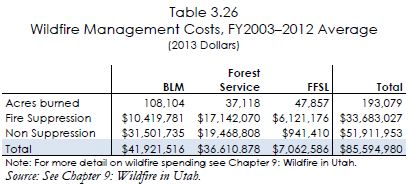An 18-month study by three universities concluded that if Utah took over most of the federal lands in the state they could anticipate revenues of $331.7 million annually while incurring costs of $280 million. Most of the income would be generated by the sale of oil, gas, and coal, while the cost of managing wildfire is estimated at $86.6 million.
The study was undertaken because Utah H.B. 148 seeks the transfer of title to 31.2 million acres of land currently managed by the federal government to the state of Utah. This accounts for more than 60 percent of the state’s land area, or five times the amount of land the state currently owns and manages. Most of the federal land in the state would be transferred under the proposal, except for national parks and designated wilderness areas. The graphic below shows the extent of the lands to be transferred.
Below is an excerpt from the portion of the 784-page study that covered wildfire management:
****
“Wildfire management (WFM) is a significant cost of land management in Utah. The three agencies with primary responsibility in managing WFM in Utah are the BLM, Forest Service and FFSL. From 2003 to 2012, the combined spending by these agencies for WFM averaged $85.6 million annually (adjusted to 2013 dollars). Of this total, suppression costs averaged $30.5 million and non-suppression costs averaged $50.2 million. Table 3.26 shows the average 10-year costs for each agency.
The variability in WFM costs by agency shown in Table 3.26 is more a reflection of aviation capability than it is of efficiency. FFSL has no aviation capability and relies on federal land managers for aviation support essential to its fire suppression efforts. In general, the BLM provides small engine aviation capability while the Forest Service bears the cost for large tanker capabili-ties. These costs are not insignificant, which explains the high suppression costs reported for the Forest Service.
Suppression is not the largest component of WFM, but it is the most volatile and most difficult to anticipate. The majority of wildfires in Utah are ignited from natural causes. Drought conditions, combined with insect infestations and climate change contribute to not just fire ignition, but fire spread, severity, duration, and ultimately cost. Most of these conditions are outside the control of human intervention.
Although WFM costs in other states are not readily available, wildfire trends for the western states show that the wildfire situation in Utah is comparatively mild. From 2003 to 2012, Utah ranked seventh of 11 western states in number of wildfires and eighth in terms of acres burned.
We expect the 10-year average cost of $86.6 million to manage wildfire in Utah is representative of the costs going forward. Over time, this amount could decrease if the state took a less aggressive approach to suppression and increased investments in fire preparedness and mitigation (reducing hazardous fuels). However, growing fire risks from the bark beetle epidemic, trends towards a drier climate, and development in the wildland-urban interface may increase the costs of fire suppression in excess of current levels.”



Not to mention relying on volatile markets like oil…gas prices at all time low + big fire season = major state deficit, something the feds can absorb, to a point, better than a state?
The Sagebrush Rebellion lives on…
Interesting – I think the Washington State legislature made a law about NOT pursuing federal land, maybe not.
I would hate to see the wildfire bill for 2014 in Washington state if the state was responsible for ALL suppression…Carlton Complex alone could be a bank buster.
$89 million seems cheap for fires these days – I spent two weeks on the Deception complex and the cost was north of 26 million – for about 5000 acres.
Maybe I’ll sit down and read all 784 pages of the study.
Destruction of the land just for a few dollars. How sad.